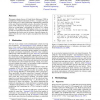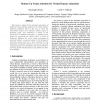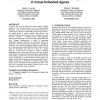23 search results - page 2 / 5 » Gaze behavior and visual attention model when turning in vir... |
ETRA
2004
ACM
13 years 8 months ago
2004
ACM
This paper evaluates the use of Visual Deictic Reference (VDR) in Collaborative Virtual Environments (CVEs). A simple CVE capable of hosting two (or more) participants simultaneou...
NIPS
2007
13 years 6 months ago
2007
Current computational models of bottom-up and top-down components of attention are predictive of eye movements across a range of stimuli and of simple, fixed visual tasks (such a...
CA
2003
IEEE
13 years 10 months ago
2003
IEEE
We present a system for the automatic generation of bottom-up visual attention behaviours in virtual humans. Bottom-up attention refers to the way in which the environment solicit...
ATAL
2008
Springer
13 years 6 months ago
2008
Springer
Currently, state of the art virtual agents lack the ability to display emotion as seen in actual humans, or even in hand-animated characters. One reason for the emotional inexpres...
ETRA
2006
ACM
13 years 10 months ago
2006
ACM
Next-generation immersive virtual environments and video games will require virtual agents with human-like visual attention and gaze behaviors. A critical step is to devise effic...



